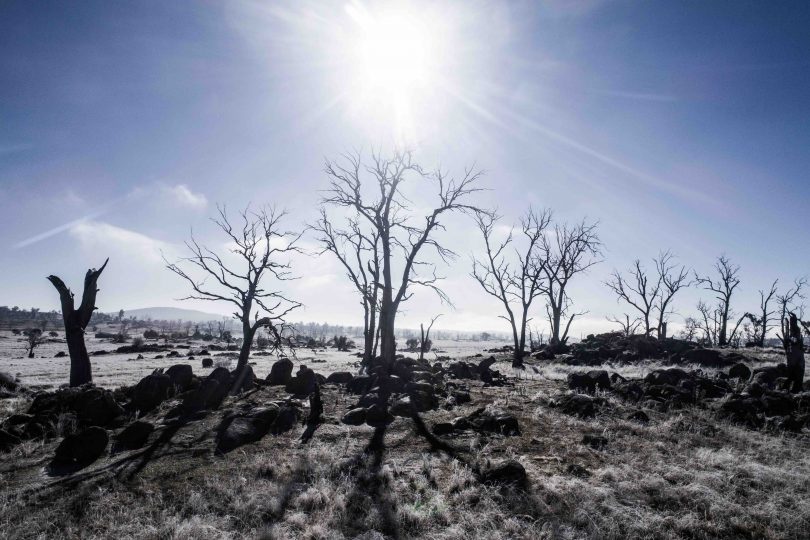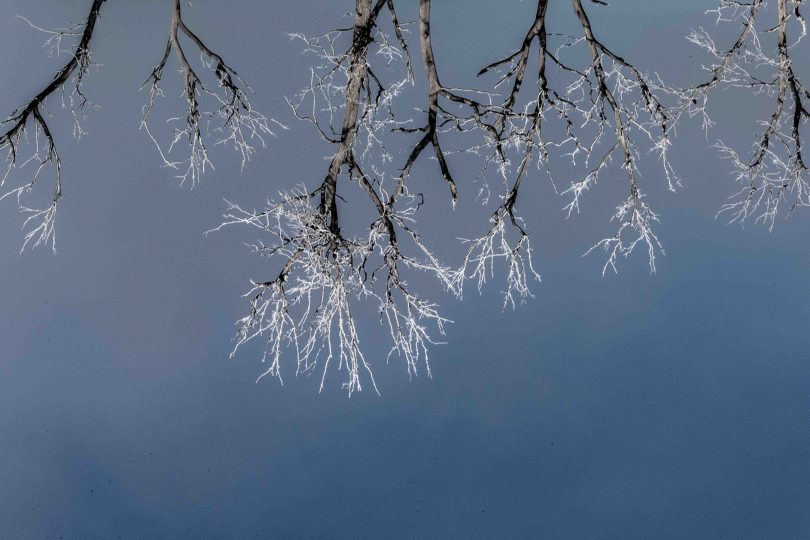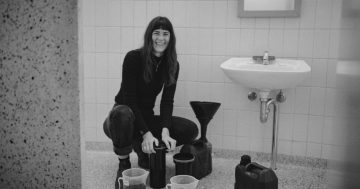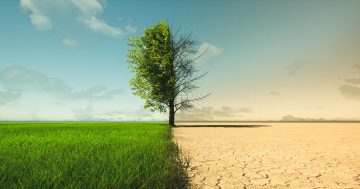
The widespread eucalyptus viminalis dieback has affected trees from Cooma to Berridale. Photos: Sammy Hawker.
A devastating swathe of dead trees across two thousand square kilometres of the Monaro prompted Michelago artist Sammy Hawker’s video installation at the Photo Access Gallery, Dieback.
And to watch the video is a haunting and sobering experience: ghostly, brittle limbs rise, white and bleached out of the Monaro mist. Lingering shots unfold across a landscape starved of shelter and punctuated by death.
Hawker is also a commercial video maker and has a long history of making work about how climate change is affecting the world in expected and unexpected ways. When she moved to the Monaro with her partner, she was struck by the impact of the dieback that began around two decades ago.

The bleached limbs of dead eucalyptus are a ghostly reminder of environmental change.
Ecologists believe that the dominant Monaro species, eucalyptus viminalis underwent a major stress event they haven’t been able to pinpoint, perhaps in the 1990s or the first decade of the 21st century. The stressor may have been drought, changing land use, possibly even the end of indigenous cool burning practices.
Whatever the cause, it’s believed that the tree’s immune and stress responses were compromised, then tapped by a native eucalyptus weevil which healthy trees can withstand. The weevils destroyed nitrogen-rich lower leaves and the trees starved to death. While other species have survived, local viminalis populations have been all but exterminated.
For Hawker, the trees and their mysterious deaths became a symbol of the speed at which the natural world is changing and how uncertain our fate is.
“My role as a visual storyteller/artist is to spread this message in a way that’s more than just the facts. We need to provide emotion too,” she says. “The video is very dark, almost post-apocalyptic, to show how much we have to lose. You see the dead trees in order to understand that we shouldn’t take for granted what we have.”
Shot mostly in winter, colour levels are low and unsaturated and the images unfold at a deliberately slow pace. “When I’m doing commercial work, the shorts are shorter, more communicative. These shots are intentionally very long and abstract to draw the viewer in to a different state of consciousness, a meditative state that slows people down.”

The loss of the dominant tree species across a wide swathe of the Monaro has been stark.
The soundtrack to the visuals comes, remarkably, from NASA’s recordings of the electromagnetic vibrations from various planets. Hawker has used the Earth tracks, which sound like white noise with blips and evoke a lifeless vacuum.
“When ecology is out of balance, the landscape becomes dysfunctional,” she says. “I tried to exercise that sense of aloneness, the uncanny feeling of a world we know but one where we couldn’t comprehend how we humans could continue living there.
“The point is that the planet is changing, in some ways, it’s becoming a new earth. More extreme weather will happen over the next few years and we can’t predict or have any idea what will happen as a result.”
While Hawker says the message can feel grim, her work is more about putting the risks into perspective. Dieback has engaged with Landcare volunteers and scientists working on the dieback to understand not only why it happened, but how the damage can be ameliorated. “It’s frustrating for scientists that the dieback wasn’t noticed early enough, so they are all on the back foot.”
Hawker’s given hope by projects like the Atlas for Living Australia, a community science initiative that encourages users to register and record changes they notice in their environment. She’s also been involved in the Greening Australia comeback project which plants trees and identifies biodiversity hotspots with Monaro landowners.
“We can’t learn nothing from the dieback,” she says. “There can be a positive outcome from this as communities come together in the region. We have to urgently spread the message about making the switch to renewables and think about the earth as a key policy fundamental.”
Dieback is at Photo Access until June 8. On Wednesday, June 5 at 6 pm, Sammy Hawker will be in conversation with restoration ecology leader Lauren van Dyke and forest scientist Cris Brack for a forum discussing Eucalyptus dieback. This is a free event, but please RSVP to Photo Access.













